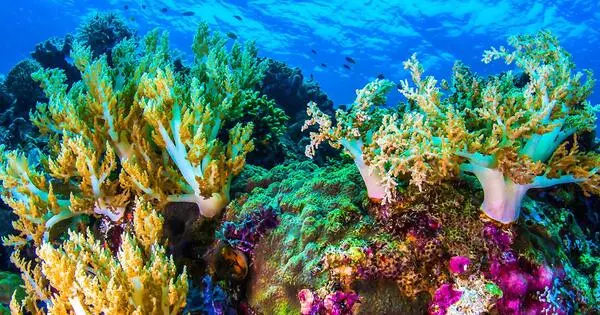Inspired by a trip to the dentist, Dr. Kate Quigley presents a new method for monitoring coral size and growth that reduces surveying time by 99%. The methodology and findings are published in the British Ecological Society journal, Methods in Ecology and Evolution.
Dr. Kate Quigley, a senior research scientist at the Minderoo Foundation who conducted the research at the Australian Institute of Marine Science, and James Cook University, has developed a new non-destructive method for rapidly and safely scanning coral – cutting down on previously laborious and lengthy surveying techniques.
Inspired by a visit to the dentist, Dr. Quigley remarked on the similarities between coral and our teeth – both being calcium-based and requiring measuring tools that can withstand wet surfaces. “One day, I was at the dentist, and they rolled out this new scanning machine. I knew immediately that it was something that could apply to scanning very small corals given corals and teeth actually share many similar properties. The rest is history!”
At the moment, it is difficult to accurately measure very small objects in 3D, especially if you are interested in measuring small live animals, like coral, without hurting them. For the first time, this new method will allow scientists to measure thousands of tiny corals fast, accurately, and without any negative health impacts on the coral.
Dr. Kate Quigley
Coral reefs are among the earth’s most productive ecosystems and provide essential nutritional and protective services to people across the globe. These important ecosystems have suffered serious declines over recent decades – spurring a flurry of research around their basic biology and restoration. Understanding the critical life stage of juvenile coral allows scientists to predict ecosystem changes, the impacts of disturbance, and their potential for recovery.
Reconstructing coral 3D models reveals insights into their health and response to pressures like rising temperatures or acidification. Several methods exist to build and assess these 3D models, yet their effectiveness is reduced when constructing measurements at small scales.
Dr. Quigley said: “At the moment, it is difficult to accurately measure very small objects in 3D, especially if you are interested in measuring small live animals, like coral, without hurting them.”
“During my Ph.D., it would take half a day to produce one scan, and I was interested in scanning hundreds of corals at a time. For the first time, this new method will allow scientists to measure thousands of tiny corals fast, accurately, and without any negative health impacts on the coral. This has the potential to expand large-scale monitoring of ocean health and for up-scaling coral reef restoration.”

To assess the effectiveness of these dental scanners, namely the ITero Element 5D Flex, Dr. Quigley measured juvenile corals at the Australian Institute of Marine Science’s National Sea Simulator. The coral, from the Great Barrier Relief, were temporarily removed from their indoor aquarium and their surface area and volume recorded before being returned to the tanks.
On average it took less than three minutes to scan and build a model of each individual coral compared to over 4 hours with previous methods – a 99% decrease in the time required to carry out such measurements. Dr. Quigley recorded equally fast and precise performance when measuring and comparing models of dead skeletons and living coral tissue. Removing the need to sacrifice live animals to take measurements.
Whilst this is a massive step forward in cutting down the time involved in monitoring and studying small marine animals, 3D scans still need to be processed manually, which slows down analysis. Dr. Quigley hopes that the next avenue for this research is to try and create an automatic analysis pipeline from scanning to measurement, potentially using AI.
At present, this technology can only be used to perform measurements out of the water. The hardware is not waterproof as the scanner relies on confocal laser technology.
“Potentially the scanner could be made completely waterproof. However, it is unclear how well the laser technology would work completely submerged underwater. We have taken this technology on the boat before and brought up wild and laboratory-reared corals for measurement, so we are getting there!”
















